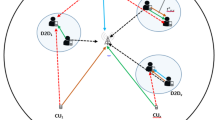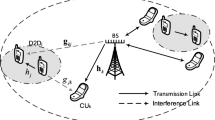Abstract
With the tremendous increment of traffic in the next generation mobile networks, device to device (D2D) communication is proposed to relieve the traffic burden of the base station and improve the overall network capacity. It supports direct communications between devices and could reuse the resources of cellular users (CUs). Despite the advantages, D2D communications bring great challenges in interference management. In this paper, we study the power control and channel allocation problems in three scenarios: (1) one CU and one D2D pair; (2) one CU and multiple D2D pairs; (3) multiple CUs and multiple D2D pairs. The goal is to coordinate the mutual interferences and maximize the overall network capacity. We derive sufficient conditions to guarantee the efficiency of D2D communications in scenarios with one CU and one D2D pair. We propose the bio-inspired PSO-P power control algorithm for the scenarios with one CU and multiple D2D pairs, and the PSO-CP algorithm for the scenarios with multiple CUs and multiple D2D pairs to jointly assign channels and powers. Simulation results show that the proposed algorithms are efficient in improving the overall network capacity.















Similar content being viewed by others
References
Cisco. (2017). Visual Networking Index.
Agiwal, M., Roy, A., & Saxena, N. (2016). Next generation 5G wireless networks: A comprehensive survey. IEEE Communications Surveys and Tutorials, 18(3), 1617–1655.
Sciancalepore, V., Mancuso, V., Banchs, A., Zaks, S., & Capone, A. (2016). Enhanced content update dissemination through D2D in 5G cellular networks. IEEE Transactions on Wireless Communications, 15(11), 7517–7530.
Gandotra, P., & Jha, R. K. (2016). Device-to-device communication in cellular networks: A survey. Journal of Network and Computer Applications, 71, 99–117.
Doppler, K., Rinne, M., Wijting, C., Ribeiro, C. B., & Hugl, K. (2009). Device-to-device communication as an underlay to LTE-advanced networks. IEEE Communications Magazine, 47(12), 42–49.
Yang, K., Martin, S., Xing, C., Wu, J., & Fan, R. (2016). Energy-efficient power control for device-to-device communications. IEEE Journal on Selected Areas in Communications, 34(12), 3208–3220.
Yu, C. H., Tirkkonen, O., Doppler, K., & Ribeiro, C. (2009). Power optimization of device-to-device communication underlaying cellular communication. In IEEE international conference on communications (pp. 1–5).
Gjendemsjo, A., Gesbert, D., Oien, G. E., & Kiani, S. G. (2006). Optimal power allocation and scheduling for two-cell capacity maximization. In International symposium on modeling and optimization in mobile, ad hoc and wireless networks (pp. 1–6).
Chen, C. S., & Oien, G. E. (2008). Optimal power allocation for two-cell sum rate maximization under minimum rate constraints. In IEEE international symposium on wireless communication systems (pp. 396–400).
Gjendemsjø, A., Gesbert, D., Øien, G. E., & Kiani, S. G. (2008). Binary power control for sum rate maximization over multiple interfering links. IEEE Transactions on Wireless Communications, 7(8), 3164–3173.
Hoang, T. D., Le, L. B., & Le-Ngoc, T. (2016). Resource allocation for D2D communication underlaid cellular networks using graph-based approach. IEEE Transactions on Wireless Communications, 15(10), 7099–7113.
Chao, S. L., Lee, H. Y., Chou, C. C., & Wei, H. Y. (2013). Bio-inspired proximity discovery and synchronization for D2D communications. IEEE Communications Letters, 17(12), 2300–2303.
Pratap, A., & Misra, R. (2015). Firefly inspired improved distributed proximity algorithm for D2D communication. In Parallel and distributed processing symposium workshop (pp. 323–328).
Mohajerani, A., & Gharavian, D. (2016). An ant colony optimization based routing algorithm for extending network lifetime in wireless sensor networks. Wireless Networks, 22(8), 2637–2647.
Su, L., Ji, Y. S., Wang, P., & Liu, F. (2013). Resource allocation using particle swarm optimization for D2D communication underlay of cellular networks. In IEEE wireless communications and networking conference (pp. 129–133).
Sun, S., & Shin, Y. (2014). Resource allocation for D2D communication using particle swarm optimization in LTE networks. In International conference on information and communication technology convergence (pp. 371–376).
Gong, W., & Wang, X. (2015). Particle swarm optimization based power allocation schemes of device-to-device multicast communication. Wireless Personal Communications, 85(3), 1261–1277.
Sun, S. J., Kim, K. Y., Shin, O. S., & Shin, Y. (2015). Device-to-device resource allocation in LTE-advanced networks by hybrid particle swarm optimization and genetic algorithm. Peer-to-Peer Networking and Applications, 9(5), 945–954.
Guo, J., Durrani, S., Zhou, X. Y., & Yanikomeroglu, H. (2017). Device-to-device communication underlaying a finite cellular network region. IEEE Transactions on Wireless Communications, 16(1), 332–347.
Elsawy, H., Hossain, E., & Alouini, M. S. (2014). Analytical modeling of mode selection and power control for underlay D2D communication in cellular networks. IEEE Transactions on Communications, 62(11), 4147–4161.
Hoang, T. D., Le, L. B., & Le-Ngoc, T. (2016). Energy-efficient resource allocation for D2D communications in cellular networks. IEEE Transactions on Vehicular Technology, 65(9), 2251–2256.
Chandrasekhar, V., & Shen, Z. (2008). Optimal uplink power control in two-cell systems with rise-over-thermal constraints. IEEE Communications Letters, 12(3), 173–175.
Xu, L., Jiang, C. X., Shen, Y. Y., Quek, T. Q. S., Han, Z., & Ren, Y. (2016). Energy efficient D2D communications: A perspective of mechanism design. IEEE Transactions on Wireless Communications, 15(11), 7272–7285.
Papandriopoulos, J., & Evans, J. S. (2009). SCALE: A low-complexity distributed protocol for spectrum balancing in multiuser DSL networks. IEEE Transactions on Information Theory, 55(8), 3711–3724.
Lee, N., Lin, X. Q., Andrews, J. G., & Heath, R. W. (2015). Power control for D2D underlaid cellular networks: Modeling, algorithms, and analysis. IEEE Journal on Selected Areas in Communications, 33(1), 1–13.
Wang, J. H., Zhu, D. H., Zhao, C. M., Li, J. C. F., & Lei, M. (2013). Resource sharing of underlaying device-to-device and uplink cellular communications. IEEE Communications Letters, 17(6), 1148–1151.
Hoang, T. D., Le, L. B., & Le-Ngoc, T. (2014). Joint subchannel and power allocation for D2D communications in cellular networks. In WCNC (pp. 1338–1343).
Azam, M., Ahmad, M., Naeem, M., Iqbal, M., Khwaja, A. S., Anpalagan, A., et al. (2016). Joint admission control, mode selection and power allocation in D2D communication systems. IEEE Transactions on Vehicular Technology, 65(9), 7322–7333.
Yin, R., Zhong, C. J., Yu, G. D., Zhang, Z. Y., Wong, K. K., & Chen, X. M. (2016). Joint spectrum and power allocation for D2D communications underlaying cellular networks. IEEE Transactions on Vehicular Technology, 65(4), 2182–2195.
Wen, S., Zhu, X. Y., Lin, Z. S., Zhang, X., & Yang, D. C. (2014). Energy efficient power allocation schemes for device-to-device (D2D) communication. In Vehicular technology conference (pp. 1–5).
Cai, X., Zheng, J., Zhang, Y., & Murata, H. (2014) A capacity oriented resource allocation algorithm for device-to-device communication in mobile cellular Networks. In IEEE international conference on communications (pp. 2233–2238).
Chen, B., Zheng, J., & Zhang, Y. (2015). A time division scheduling resource allocation for D2D communication in cellular networks. In IEEE international conference on communications (pp. 5422–5428).
Chen, B., Zheng, J., Zhang, Y., & Murata, H. (2014). SARA a service-aware resource allocation scheme for device-to-device communication underlaying cellular networks. In IEEE global communications conference (pp. 350–358).
Cai, X., Zheng, J., & Zhang, Y. (2015). A graph coloring based resource allocation algorithm for D2D communication in cellular networks. In IEEE international conference on communications (pp. 5429–5434).
Vlachos, C., Elshaer, H., Chen, J., Friderikos, V., & Dohler, M. (2017). Bio-inspired resource allocation for relay-aided device-to-device communications. In IEEE 84th vehicular technology conference (VTC-Fall) (pp. 1–6).
Chen, B., Zhao, M. J., Lei, M., & Zhang, L. (2016). Energy-efficient MIMO precoding and power allocation for device-to-device underlay communication in cellular networks. In Vehicular technology conference (pp. 1–5).
Liang, T., Zhang, T. K., Cao, J. L., & Feng, C. Y. (2015). Joint resource allocation and power control scheme for device-to-device communication underlaying cellular networks. In International symposium on wireless personal multimedia communications (pp. 568–572).
Tang, R., Dong, J. J., Zhu, Z. C., Liu, J. H., Zhao, J., & Qu, H. (2015). Resource allocation for underlaid device-to-device communication by incorporating both channel assignment and power control. In Fifth international conference on communication systems and network technologies (pp. 432–436).
Xu, W., Li, S., Xu, Y., & Lin, X. (2015). Underlaid-D2D-assisted cooperative multicast based on social networks. Peer-to-Peer Networking and Applications, 9(5), 923–935.
Friis, H. T. (1946). A note on a simple transmission formula. Proceedings of the IRE, 34(5), 254–256.
Shannon, C. E. (1948). A mathematical theory of communication. ACM SIGMOBILE Mobile Computing & Communications Review, 27(4), 623–656.
Kennedy, J., & Eberhart, R. (1995). Particle swarm optimization. In Proceedings of the IEEE international conference on neural networks (pp. 1942–1948).
Kennedy, J., & Eberhart, R. C. (1997). A discrete binary version of the particle swarm algorithm. IEEE International Conference on Systems, Man and Cybernetics, 5, 4104–4108.
Acknowledgements
This work is supported by the Innovation Young Researcher Program (No. 2042016kf0020) and the China’s Postdoctoral Science Fund (No. 2017M612503).
Author information
Authors and Affiliations
Corresponding author
Rights and permissions
About this article
Cite this article
Xu, J., Guo, C. & Yang, J. Bio-inspired power control and channel allocation for cellular networks with D2D communications. Wireless Netw 25, 1273–1288 (2019). https://doi.org/10.1007/s11276-018-1728-x
Published:
Issue Date:
DOI: https://doi.org/10.1007/s11276-018-1728-x




